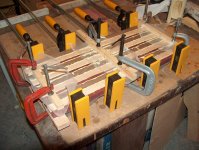As Jay said, alternating the clamps as you apply them, but start with two, one near each end to hold the pieces together. Then one in the middle, applied from the opposite side. Then apply the rest, so the end result is clamps alternating from side to side (it doesn't have to be perfect). Once the clamps are all on and the work pieces are all aligned, then tighten each clamp to the desired clamping pressure alternating from end to end to keep the pressure at all clamps as equal as possible. Wax paper between the clamp bar or pipe certainly helps keep the glue off of them. I apply a couple of coats of Johnson's Paste Wax to my clamp bars and pipes, and this works too. I use the bars or pipes of the clamps, positioned against the work, to keep the assembly flat but cauls with a slight curve work well too.
You should also study the grain direction of each piece by looking at their ends. Alternating the grain curves
will prevent the panel from developing a significant curve as it's moisture content changes. It will become more or less wavy when it's moisture content increases and decreases. Avoid wood that has a spiraling grain structure, because it will cause a slight twist in the finished panel as it's moisture content changes. For a really stable panel, all of the grain lines in all of the work pieces need to be straight across from panel surface to surface. Quarter sawn wood will have it's grain running closer to this perfect solution. Then when the moisture content changes the panel will remain much flatter and just change in width with the changes in moisture content.
For some projects you can create a close imitation of quarter sawn wood by ripping your work into square strips, where the width and thickness of each are the same. Then turn each strip 90 degrees, so all the grain lines will run across your assembled panel, and then glue all of these strips back together to form your panel.
It's a lot more cutting and gluing, but the end result produces a panel that will be much more likely to remain flat, and the cost of the materials will be much less than the price of quarter sawn material, if you can even find it. I once did this with construction grade 2by wood and made a very nice 1 1/2" thick pine table top for a coffee table that has remained very stable and flat over the last 20+ years.
When doing very wide panels, it's wise to not try to glue all joints in one step. Glue in groups of up to about 12" in width (but they can be narrower than this), and when dry, glue these wider assemblies together. The gluing and the assembly process is much easier to manage this way. Otherwise you will need to use very slow setting glue, because the glue will be setting up before you can finish gluing and clamping them together. If you can't apply the glue and get them clamped in less than about 15 minutes, you will need to work with smaller groups or slower setting glue.
Charley


